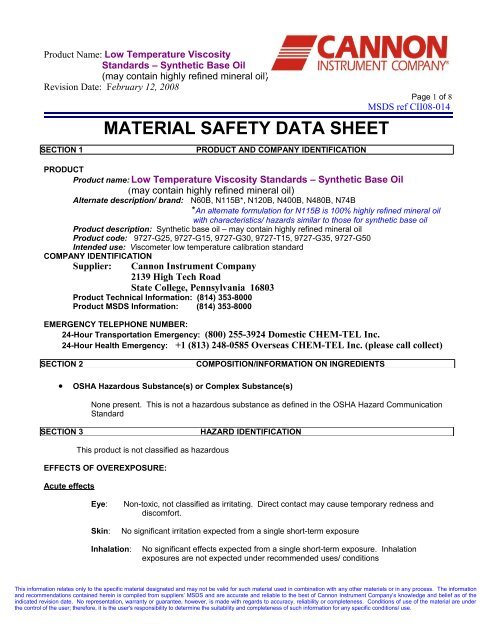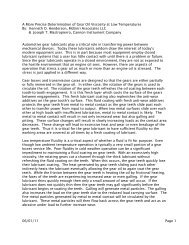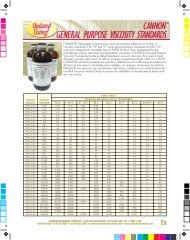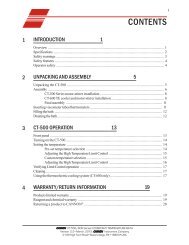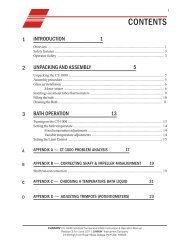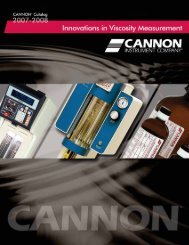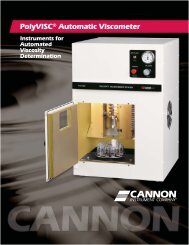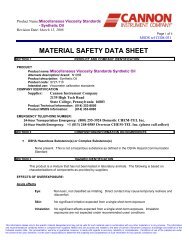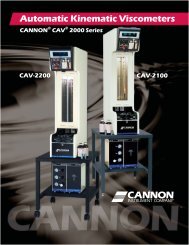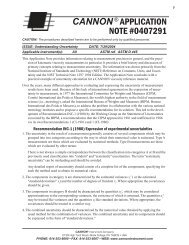MATERIAL SAFETY DATA SHEET - Cannon Instrument Company
MATERIAL SAFETY DATA SHEET - Cannon Instrument Company
MATERIAL SAFETY DATA SHEET - Cannon Instrument Company
Create successful ePaper yourself
Turn your PDF publications into a flip-book with our unique Google optimized e-Paper software.
Product Name: Low Temperature Viscosity<br />
Standards – Synthetic Base Oil<br />
(may contain highly refined mineral oil)<br />
Revision Date: February 12, 2008<br />
SECTION 1<br />
<strong>MATERIAL</strong> <strong>SAFETY</strong> <strong>DATA</strong> <strong>SHEET</strong><br />
PRODUCT AND COMPANY IDENTIFICATION<br />
Page 1 of 8<br />
MSDS ref CII08-014<br />
PRODUCT<br />
Product name: Low Temperature Viscosity Standards – Synthetic Base Oil<br />
(may contain highly refined mineral oil)<br />
Alternate description/ brand: N60B, N115B*, N120B, N400B, N480B, N74B<br />
*An alternate formulation for N115B is 100% highly refined mineral oil<br />
with characteristics/ hazards similar to those for synthetic base oil<br />
Product description: Synthetic base oil – may contain highly refined mineral oil<br />
Product code: 9727-G25, 9727-G15, 9727-G30, 9727-T15, 9727-G35, 9727-G50<br />
Intended use: Viscometer low temperature calibration standard<br />
COMPANY IDENTIFICATION<br />
Supplier:<br />
<strong>Cannon</strong> <strong>Instrument</strong> <strong>Company</strong><br />
2139 High Tech Road<br />
State College, Pennsylvania 16803<br />
Product Technical Information: (814) 353-8000<br />
Product MSDS Information: (814) 353-8000<br />
EMERGENCY TELEPHONE NUMBER:<br />
24-Hour Transportation Emergency: (800) 255-3924 Domestic CHEM-TEL Inc.<br />
24-Hour Health Emergency: +1 (813) 248-0585 Overseas CHEM-TEL Inc. (please call collect)<br />
SECTION 2<br />
COMPOSITION/INFORMATION ON INGREDIENTS<br />
• OSHA Hazardous Substance(s) or Complex Substance(s)<br />
None present. This is not a hazardous substance as defined in the OSHA Hazard Communication<br />
Standard<br />
SECTION 3<br />
HAZARD IDENTIFICATION<br />
This product is not classified as hazardous<br />
EFFECTS OF OVEREXPOSURE:<br />
Acute effects<br />
Eye: Non-toxic, not classified as irritating. Direct contact may cause temporary redness and<br />
discomfort.<br />
Skin:<br />
No significant irritation expected from a single short-term exposure<br />
Inhalation:<br />
No significant effects expected from a single short-term exposure. Inhalation<br />
exposures are not expected under recommended uses/ conditions<br />
This information relates only to the specific material designated and may not be valid for such material used in combination with any other materials or in any process. The information<br />
and recommendations contained herein is compiled from suppliers’ MSDS and are accurate and reliable to the best of <strong>Cannon</strong> <strong>Instrument</strong> <strong>Company</strong>’s knowledge and belief as of the<br />
indicated revision date. No representation, warranty or guarantee, however, is made with regards to accuracy, reliability or completeness. Conditions of use of the material are under<br />
the control of the user; therefore, it is the user's responsibility to determine the suitability and completeness of such information for any specific conditions/ use.
Product Name: Low Temperature Viscosity<br />
Standards – Synthetic Base Oil<br />
(may contain highly refined mineral oil)<br />
Revision Date: February 12, 2008<br />
Oral:<br />
Prolonged/ repeated exposure effects<br />
Low ingestion hazard in normal use. If ingested, do not induce vomiting.<br />
Page 2 of 8<br />
MSDS ref CII08-014<br />
Skin:<br />
Not classified as hazardous<br />
Inhalation:<br />
Not classified as hazardous<br />
Oral:<br />
Not classified as hazardous<br />
Repeated and/or prolonged exposure may cause irritation to the skin, eyes or respiratory tract.<br />
Signs and symptoms of overexposure:<br />
Irritation and/ or redness of eyes and skin<br />
Medical conditions aggravated by exposure<br />
None identified<br />
Note:<br />
Low viscosity hydrocarbon liquids (e.g., the predominant component of N60B) can cause chemical<br />
pneumonitis. Therefore, if the material is ingested, do not induce vomiting, as this can result in<br />
aspiration into the lungs.<br />
NFPA HAZARD ID: Health: 0 Flammability: 1 Reactivity: 0<br />
(National Fire Protection Association)<br />
NOTE: This material should not be used for any other purpose than the intended use in Section 1<br />
SECTION 4<br />
INHALATION<br />
SKIN CONTACT<br />
EYE CONTACT<br />
INGESTION<br />
FIRST AID MEASURES<br />
If respiratory irritation, dizziness, nausea, or unconsciousness occurs due to excessive<br />
vapor or mist exposure, seek medical assistance.<br />
Wash contact areas with soap and water. Remove and clean oil soaked clothing daily<br />
and wash affected area.<br />
Flush thoroughly with water. If irritation persists, call a physician.<br />
Seek medical attention. Do not induce vomiting.<br />
NOTE TO PHYSICIAN: Treat symptomatically. Low viscosity hydrocarbon liquids (e.g., the predominant<br />
component of N60B) can cause chemical pneumonitis if aspirated into the lungs).<br />
Therefore, if the material is ingested, do not induce vomiting, as this can result in<br />
aspiration into the lungs.<br />
SECTION 5<br />
FIRE-FIGHTING MEASURES<br />
This information relates only to the specific material designated and may not be valid for such material used in combination with any other materials or in any process. The information<br />
and recommendations contained herein is compiled from suppliers’ MSDS and are accurate and reliable to the best of <strong>Cannon</strong> <strong>Instrument</strong> <strong>Company</strong>’s knowledge and belief as of the<br />
indicated revision date. No representation, warranty or guarantee, however, is made with regards to accuracy, reliability or completeness. Conditions of use of the material are under<br />
the control of the user; therefore, it is the user's responsibility to determine the suitability and completeness of such information for any specific conditions/ use.
Product Name: Low Temperature Viscosity<br />
Standards – Synthetic Base Oil<br />
(may contain highly refined mineral oil)<br />
Revision Date: February 12, 2008<br />
Page 3 of 8<br />
MSDS ref CII08-014<br />
EXTINGUISHING MEDIA<br />
Appropriate extinguishing media: Carbon dioxide, foam, dry chemical and water fog. Water can be<br />
used to cool fire exposed containers. For large fires, use alcohol- or universal-type foams. Water<br />
jets should not be used<br />
FIRE FIGHTING<br />
Fire fighting instructions: Self-contained breathing apparatus and protective clothing should be<br />
worn in fighting large fires involving chemicals. Determine the need to evacuate or isolate the area<br />
according to your local emergency plan. Use water spray to keep the exposed containers cool.<br />
Prevent runoff from fire control or dilution from entering streams, sewers, or drinking water supply.<br />
Unusual fire hazards: None identified<br />
Hazardous combustion products: Thermal breakdown of this product during fire or very high heat<br />
conditions may evolve the following hazardous decomposition products: Fumes, smoke, carbon<br />
monoxide, aldehydes and other decomposition products<br />
FLAMMABILITY PROPERTIES<br />
Flash point °C (°F) [method]: >219 o C/ 425 o F<br />
Flammable limits (approx. Volume % in air) – not determined<br />
Autoignition temperature °C (°F): >310 o C / 590 o F<br />
SECTION 6<br />
ACCIDENTAL RELEASE MEASURES<br />
NOTIFICATION PROCEDURES: Report spills/releases to appropriate authorities as required.<br />
CONTAINMENT/ CLEANUP<br />
PROCEDURES IF <strong>MATERIAL</strong> IS RELEASED OR SPILLED:<br />
LAND SPILL: Shut off source taking normal safety precautions. Take measures to minimize<br />
the effects on ground water. Recover by pumping or contain spilled material with sand or other<br />
suitable absorbent and remove mechanically into containers. If necessary, dispose of<br />
adsorbed residues as required by regulations (see Section 13.)<br />
WATER SPILL: Confine the spill immediately with booms. Notify relevant authorities. Remove<br />
from the surface by skimming or with suitable absorbents<br />
ENVIRONMENTAL PRECAUTIONS: Prevent material from entering sewers, water sources or low lying<br />
areas; advise the relevant authorities if it has, or if it contaminates soil/vegetation.<br />
PERSONAL PROTECTIVE EQUIPMENT FOR SPILLS<br />
Eyes:<br />
Skin:<br />
Use proper protection – safety glasses as a minimum<br />
Washing at mealtime and end-of-shift is adequate<br />
Inhalation:<br />
No respiratory protection should be needed<br />
Precautionary measures:<br />
Avoid eye contact. Use reasonable care<br />
SECTION 7<br />
HANDLING AND STORAGE<br />
HANDLING<br />
Avoid prolonged/ repeated skin contact. Use with adequate ventilation<br />
STORAGE:<br />
This information relates only to the specific material designated and may not be valid for such material used in combination with any other materials or in any process. The information<br />
and recommendations contained herein is compiled from suppliers’ MSDS and are accurate and reliable to the best of <strong>Cannon</strong> <strong>Instrument</strong> <strong>Company</strong>’s knowledge and belief as of the<br />
indicated revision date. No representation, warranty or guarantee, however, is made with regards to accuracy, reliability or completeness. Conditions of use of the material are under<br />
the control of the user; therefore, it is the user's responsibility to determine the suitability and completeness of such information for any specific conditions/ use.
Product Name: Low Temperature Viscosity<br />
Standards – Synthetic Base Oil<br />
(may contain highly refined mineral oil)<br />
Revision Date: February 12, 2008<br />
Page 4 of 8<br />
MSDS ref CII08-014<br />
Keep containers closed when not in use. Do not store in open or unlabelled containers. Store in<br />
a cool, dry place; do not store near heat, sparks, flame or strong oxidants.<br />
SPECIAL PRECAUTIONS<br />
Prevent small spills and leakages to optimize housekeeping and avoid slip hazards.<br />
EMPTY CONTAINER WARNING<br />
Empty containers retain residue (liquid and/or vapor) and can be dangerous. DO NOT<br />
PRESSURIZE, CUT, WELD, BRAZE, SOLDER, DRILL, GRIND OR EXPOSE SUCH<br />
CONTAINERS TO HEAT, FLAME, SPARKS, STATIC ELECTRICITY, OR OTHER SOURCES<br />
OF IGNITION; THEY MAY EXPLODE AND CAUSE INJURY OR DEATH. Do not attempt to<br />
refill or clean container since residue is difficult to remove. Empty drums should be completely<br />
drained, properly bunged and promptly returned to a drum reconditioner. All containers should<br />
be disposed of in an environmentally safe manner and in accordance with governmental<br />
regulations.<br />
STORAGE<br />
Use reasonable care and store away from oxidizing materials<br />
SECTION 8<br />
EXPOSURE CONTROLS/PERSONAL PROTECTION<br />
EXPOSURE LIMIT VALUES<br />
No workplace exposure limits have been established for this product<br />
ENGINEERING CONTROLS<br />
General ventilation is recommended. No local exhaust ventilation should be needed<br />
PERSONAL PROTECTION<br />
Personal protective equipment selections vary based on potential exposure conditions such as<br />
applications, handling practices, concentration and ventilation. Information on the selection of<br />
protective equipment for use with this material, as provided below, is based upon intended,<br />
normal usage.<br />
Respiratory Protection:<br />
No respiratory protection should be needed under recommended conditions of use<br />
Hand Protection:<br />
No special protection is needed<br />
Eye Protection:<br />
Use proper protection – safety glasses as a minimum<br />
Specific Hygiene Measures:<br />
Washing at mealtime and end-of-shift is adequate. Provide eyewash fountains in the event of<br />
accidental splash to the eyes<br />
SECTION 9<br />
PHYSICAL AND CHEMICAL PROPERTIES<br />
Typical physical and chemical properties are given below. Consult the <strong>Cannon</strong> <strong>Instrument</strong> <strong>Company</strong> as indicated<br />
in Section 1 for additional data.<br />
GENERAL INFORMATION<br />
Physical state:<br />
Clear liquid<br />
This information relates only to the specific material designated and may not be valid for such material used in combination with any other materials or in any process. The information<br />
and recommendations contained herein is compiled from suppliers’ MSDS and are accurate and reliable to the best of <strong>Cannon</strong> <strong>Instrument</strong> <strong>Company</strong>’s knowledge and belief as of the<br />
indicated revision date. No representation, warranty or guarantee, however, is made with regards to accuracy, reliability or completeness. Conditions of use of the material are under<br />
the control of the user; therefore, it is the user's responsibility to determine the suitability and completeness of such information for any specific conditions/ use.
Product Name: Low Temperature Viscosity<br />
Standards – Synthetic Base Oil<br />
(may contain highly refined mineral oil)<br />
Revision Date: February 12, 2008<br />
Form:<br />
Color:<br />
Odor:<br />
Odor threshold:<br />
Liquid<br />
clear colorless<br />
Characteristic odor<br />
not available<br />
Page 5 of 8<br />
MSDS ref CII08-014<br />
IMPORTANT HEALTH, <strong>SAFETY</strong> AND ENVIRONMENTAL INFORMATION<br />
Specific Gravity @ 25 o C: Lighter than water<br />
Bulk density g/cc: not determined<br />
Density, kg/m 3 (lbs./gal.): not determined<br />
Flash point °C (°F) [method]: >219 o C/ 425 o F<br />
Flammable limits (approx. Volume % in air) - not determined<br />
Ignition temperature (polymers) °C (°F): not determined<br />
Autoignition temperature °C (°F): >590 o F/ 310 o C<br />
Boiling point/range °C (°F): not determined<br />
Vapor density @ 101 kPa (air =1): not determined<br />
Vapor pressure @ 20°C, kPa (mm Hg): not determined<br />
Evaporation rate (n-butyl acetate =1): not determined<br />
pH:<br />
not applicable<br />
Log Pow (n-Octanol/water partition coefficient): not determined<br />
Solubility in water (20 °C): negligible<br />
Viscosity: see product specification<br />
OTHER INFORMATION<br />
Freezing point °C (°F): not determined<br />
Melting Point °C (°F): not determined<br />
Pour point °C (°F):<br />
not determined<br />
Molecular weight:<br />
not determined<br />
Hygroscopic:<br />
no<br />
Coefficient of thermal expansion: not determined<br />
SECTION 10<br />
STABILITY AND REACTIVITY<br />
STABILITY:<br />
Stable<br />
CONDITIONS TO AVOID:<br />
<strong>MATERIAL</strong>S TO AVOID:<br />
Extreme heat and high energy sources of ignition.<br />
Strong oxidizing agents/ materials can cause a reaction<br />
HAZARDOUS DECOMPOSITION PRODUCTS:<br />
HAZARDOUS POLYMERIZATION:<br />
Product does not decompose at ambient temperatures.<br />
Hazardous polymerization will not occur<br />
SECTION 11<br />
TOXICOLOGICAL INFORMATION<br />
Information from suppliers indicates that the product is not classifiable as hazardous<br />
SECTION 12<br />
ECOLOGICAL INFORMATION<br />
Environmental fate and distribution<br />
This information relates only to the specific material designated and may not be valid for such material used in combination with any other materials or in any process. The information<br />
and recommendations contained herein is compiled from suppliers’ MSDS and are accurate and reliable to the best of <strong>Cannon</strong> <strong>Instrument</strong> <strong>Company</strong>’s knowledge and belief as of the<br />
indicated revision date. No representation, warranty or guarantee, however, is made with regards to accuracy, reliability or completeness. Conditions of use of the material are under<br />
the control of the user; therefore, it is the user's responsibility to determine the suitability and completeness of such information for any specific conditions/ use.
Product Name: Low Temperature Viscosity<br />
Standards – Synthetic Base Oil<br />
(may contain highly refined mineral oil)<br />
Revision Date: February 12, 2008<br />
Page 6 of 8<br />
MSDS ref CII08-014<br />
No specific environmental data are available for this product; this assessment is based on<br />
information for similar components/ products.<br />
Air:<br />
This product has a low vapor pressure. As a result, it is unlikely to become an<br />
atmospheric contaminant under recommended conditions of use<br />
Water: This product has low water solubility. Since it has a specific gravity of
Product Name: Low Temperature Viscosity<br />
Standards – Synthetic Base Oil<br />
(may contain highly refined mineral oil)<br />
Revision Date: February 12, 2008<br />
Page 7 of 8<br />
MSDS ref CII08-014<br />
United States Department of Transportation (US DOT):<br />
UN/ID# Proper Shipping Name Class/Division Hazard Label(s) Packing Group<br />
Not Regulated As A Hazardous Material Or Dangerous Good For This Mode of Transportation.<br />
International Air Transport Association (IATA):<br />
UN/ID# Proper Shipping Name Class/Division Hazard Label(s) Packing Group<br />
Not Regulated As A Hazardous Material Or Dangerous Good For This Mode of Transportation.<br />
SECTION 15<br />
REGULATORY INFORMATION<br />
OSHA HAZARD COMMUNICATION STANDARD: When used for its intended purposes, this material is not<br />
classified as hazardous in accordance with OSHA 29 CFR<br />
1910.1200.<br />
NATIONAL CHEMICAL INVENTORY LISTING:<br />
This product, and/ or its constituents, is listed on the US<br />
EPA/ TSCA (Toxic Substances Control Act) Inventory<br />
COMMUNITY RTK:<br />
Chemical Name CAS Number Typical Value Component TPQ Product TPQ<br />
Synthetic base oils 68037-01-4 100% Not applicable Not applicable<br />
Note: An alternate formulation for N115B is 100% highly refined mineral oil (no CAS#s available). The hazards and<br />
physical properties of the highly refined mineral oils are substantially similar to those for synthetic base oils<br />
Section 304 CERCLA HAZARDOUS SUBSTANCES:<br />
This product contains no chemicals that are classified as hazardous under CERCLA<br />
SARA (311/312) REPORTABLE HAZARD CATEGORIES:<br />
This product contains no chemicals that are classified as hazardous under SARA 312<br />
SARA (313) TOXIC RELEASE INVENTORY:<br />
This product contains no chemicals that are regulated under SARA 313<br />
International chemical inventories and hazard classifications<br />
This product and/ or its components are on the Canadian Domestic Substance List/ NDSL, or are<br />
otherwise in compliance with related regulations.<br />
WHMIS Classifications (Canada):<br />
This series of fluids is not controlled under provisions of WHMIS<br />
This product and/ or its components are on EINECS (European Inventory of Existing Chemical<br />
Substances) and/ or ELINCS (European Library of Notified Chemical Substances), or is otherwise<br />
This information relates only to the specific material designated and may not be valid for such material used in combination with any other materials or in any process. The information<br />
and recommendations contained herein is compiled from suppliers’ MSDS and are accurate and reliable to the best of <strong>Cannon</strong> <strong>Instrument</strong> <strong>Company</strong>’s knowledge and belief as of the<br />
indicated revision date. No representation, warranty or guarantee, however, is made with regards to accuracy, reliability or completeness. Conditions of use of the material are under<br />
the control of the user; therefore, it is the user's responsibility to determine the suitability and completeness of such information for any specific conditions/ use.
Product Name: Low Temperature Viscosity<br />
Standards – Synthetic Base Oil<br />
(may contain highly refined mineral oil)<br />
Revision Date: February 12, 2008<br />
Page 8 of 8<br />
MSDS ref CII08-014<br />
in conformance with related EU directives/ regulations.<br />
EU Hazard Classification, risk and safety phrases (Europe):<br />
This series of fluids is not classified as dangerous according to EU directives and regulations.<br />
SECTION 16<br />
OTHER INFORMATION<br />
THIS <strong>SAFETY</strong> <strong>DATA</strong> <strong>SHEET</strong> CONTAINS THE FOLLOWING REVISIONS:<br />
Revision Summary:<br />
• October 15, 2005 -- This MSDS has been fully reviewed and reformatted to conform to changes<br />
in standard format<br />
• March 20, 2007: Added Canadian and European classification and labeling information, based<br />
on current regulations and/or recommendations from suppliers (see Section 15)<br />
• May 17, 2007: Updated and standardized format of Transport Information (see Section 14)<br />
• February 12, 2008: Removed N14B, N25B, and N38B and transferred to a new MSDS [36] to<br />
segregate base oil types. Corrected errors in Product Codes (see Section 1). Updated CAS#<br />
for synthetic base oil in Community RTK (see Section 15).<br />
NOTES:<br />
This information relates only to the specific material designated and may not be valid for such material used in combination with any other materials or in any process. The information<br />
and recommendations contained herein is compiled from suppliers’ MSDS and are accurate and reliable to the best of <strong>Cannon</strong> <strong>Instrument</strong> <strong>Company</strong>’s knowledge and belief as of the<br />
indicated revision date. No representation, warranty or guarantee, however, is made with regards to accuracy, reliability or completeness. Conditions of use of the material are under<br />
the control of the user; therefore, it is the user's responsibility to determine the suitability and completeness of such information for any specific conditions/ use.


